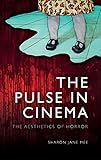The Pulse in Cinema : The Aesthetics of Horror / Sharon Jane Mee.
Material type: TextPublisher: Edinburgh : Edinburgh University Press, [2022]Copyright date: ©2020Description: 1 online resource (232 p.) : 26 B/W illustrationsContent type:
TextPublisher: Edinburgh : Edinburgh University Press, [2022]Copyright date: ©2020Description: 1 online resource (232 p.) : 26 B/W illustrationsContent type: - 9781474475846
- 9781474475860
- 791.436164
- PN1995.9.H6
- online - DeGruyter
| Item type | Current library | Call number | URL | Status | Notes | Barcode | |
|---|---|---|---|---|---|---|---|
 eBook
eBook
|
Biblioteca "Angelicum" Pont. Univ. S.Tommaso d'Aquino Nuvola online | online - DeGruyter (Browse shelf(Opens below)) | Online access | Not for loan (Accesso limitato) | Accesso per gli utenti autorizzati / Access for authorized users | (dgr)9781474475860 |
Frontmatter -- Contents -- Figures -- Acknowledgements -- Introduction -- 1. The Rhythm of Life: The Pulse in the Image -- 2. The Rhythm of Life: The Pulse in the Spectator -- 3. Aisthesis and Dispositif: The Pulse and Its Analogues -- 4. Automutilation and Metonymy: The Economy of the Pulse -- 5. Blood and Convulsive Affect: Vectors of the Pulse as Sovereign Operations -- Bibliography -- Filmography -- Index
restricted access online access with authorization star
http://purl.org/coar/access_right/c_16ec
A philosophical enquiry into the pulse as the affective force in cinemaDevelops a concept of the pulse and argues for the importance of its use in cinema spectatorship theoryBuilds on ideas of rhythm in early and experimental cinema to develop a progressive theory that is valuable for a cinematic understanding of body horrorAnalyses five body horror films - Le Sang des bêtes/Blood of the Beasts, The Tingler, Dawn of the Dead, L’aldilà/The Beyond and Possession - using aspects of the pulseProvides an innovative approach to the economy of cinema to rethink the energetic relation between the image and the spectatorIntegrates concepts from theorists Jean-François Lyotard, Gilles Deleuze, and Georges Bataille into the study of cinema spectatorship When we think of the pulse in cinema, we may think of the heartbeat of the spectator as they respond to affective or moving scenes in the film, or how fast-paced and shocking images exacerbate this affective response. Conceptually extending cinema spectatorship, The Pulse in Cinema contends that cinema is an energetic arrangement of affective and intense forces, where the image and the spectator are specific components. Analysing body horror films such as The Tingler (1959), Dawn of the Dead (1978) and The Beyond (1981), this book builds on Lyotard’s concept of the dispositif, Deleuze’s work on sensation and Bataille’s economic theory to conceptualise a pulse in cinema, arguing for its importance in cinema spectatorship theory.
Mode of access: Internet via World Wide Web.
In English.
Description based on online resource; title from PDF title page (publisher's Web site, viewed 27. Jan 2023)


